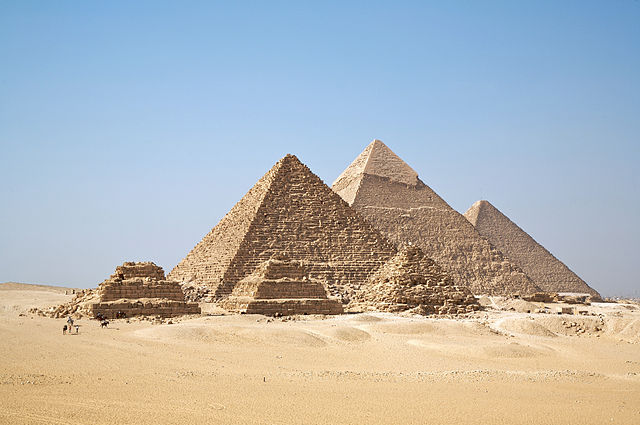
Gizah Pyramids – courtesy Wikipedia
People all over the world are fascinated with ancient Egypt. People have been mystified about the pyramids, wanting to know why a pyramid design was used rather than other forms. How were the blocks of stone moved and erected, and what type of natural forces are involved within the pyramids which some people call “pyramid power”? Here are some answers.
One purpose of the pyramid was to be a special center for preservation. The body of the dead pharaoh was put into a coffin or even a set of coffins was placed inside well protected from the environment by enormous sandstone block. The shape of the pyramids over the past 5,000 years, resembles a cone pointing upward or skyward. The ancients believed this type of structure enabled the deceased to ascend to a life after death in the “Field of Reeds” or if desired descend back to earth. A pyramid; as it was thought by the ancients could channel spiritual energy, much like a funnel.
In the entire world it has been said that only the great Pyramids of Egypt are “true” pyramids. While this point can be mathematically argued what this really means, the base of the great Egyptian pyramids is the only design that forms a true square and thus considered a “Square Pyramid”. Globally the Myan’s, and cultures in Mexico, Peru, even Sudan who have constructed pyramids over thousands of years, however their shape has been defined by a rectangular base. Perhaps purists assume that only the Egyptian square based pyramids are the perfect way to go. Square or rectangular may not be as important as why did these people decided on the shape of a pyramid in the first place?
From an engineering prospective the pyramidal shape is one of the strongest structures and easiest to build. In a basic design, once the base is built one can simply walk up the side of a pyramid to lay the next course of block, and so on and so forth until you run out of building space. Therefore a pyramid can rise as high as needed as long as the block can be lifted to build the next level. It’s been suggested in that in the Egyptian method; the tops were finished first then workers would lay additional block to the lower levels to even out the angles. Perhaps it isn’t surprising why such similar massive pyramids have been erected all over the earth without known collaboration between the ancient societies who made them.
The base of a pyramid is wide enough to help support its massive weight and of course to keep the angles symmetrical. The height of a pyramid is limited by how large the base is built. The pyramids are made of powerful rocks, as sandstone that are also very thick, and weight on an average 2.5 tons each, or more which gives extreme protection inside the pyramids against sandstorms, rainstorms, and hailstones storms.
Physicists at the University of Amsterdam examined the problem of the forces needed to move the sled used containing heavy sandstone block across the sandy Egyptian soil. Naturally pulling such weight causes the sand to bind and clump rather than stay flat under the tremendous weight of the sleds. Then a clue – in a painting from 1800 BC ancient Egyptian’s can be seen moving a 60 ton statue along the desert sands in a sled. A worker in front is pouring water onto the sand, which for years was once thought to be a part of a ceremony.
Robert Bonn, professor of physics conducted experiments and concluded that water in the right proportions fills the space between the sand particles increasing their stiffness. This makes the sand sticky and bind together allowing the massive sleds to glide easier with much less effort. The same principals also apply to use of wet sand rather than dry in building a sand castle, he explained. This may very well be a crucial step in how the blocks were transported to the site where the Pyramids were built.
Lastly the pyramid structure, on its outside rocks, may have had a specialized coating of limestone with a sticky, adhesive substance, like pitch that dried in the hot desert sunlight to further help safeguard and weatherize the pyramids and to help keep heat in.
For more information and further reading:


